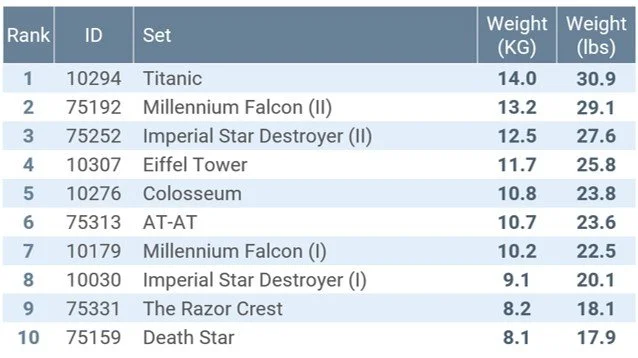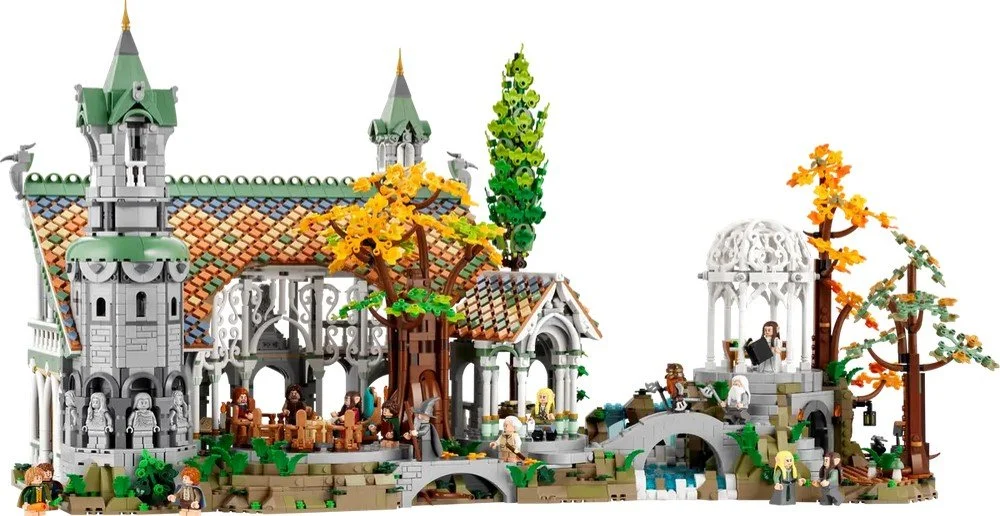Big Beasts: The Rise of Large LEGO Sets
/Since 2016, there has been a noticeable increase in the number of ‘big’ LEGO sets, and what used to be a relatively rare event is becoming run-of-the-mill. As well as identifying the best method to judge the size of a set, we’ll appraise recent trends and the wider landscape of big sets, and look back on two decades of LEGO’s ‘Big Beasts’.
Image by Chris Clarke
So What Is A ‘Big’ Set Anyway?
There is no conclusive way to measure how ‘big’ a LEGO set is, which is essential if we want to assess the value for money (or lack thereof). Piece count has been the traditional measure, but the release of 31203 World Map and its 11,000 or so tiny round tiles, took away any remaining authority the already flawed ‘price per piece’ metric had.
Image © The LEGO Group 31203 World Map
Weight Is Better Than Piece Count
Price per gram (or kilogram or pound) has often been suggested as a better measure than price per piece to judge the value of a set. (See Brick Architect’s many set reviews and weight analyses.) And although getting reliable information for thousands of sets is not really feasible, we can still assess if weight is actually a better metric than piece count by looking at a smaller sample.
194 sets from 2021 (with more than 300 pieces) were selected and the correlation between pieces, weight and price was assessed. Weight information was obtained from BrickLink, which is the best data available short of buying every set and perching them one by one on my bathroom scale.
The results are pretty conclusive. The correlation between piece count and retail price is just 0.65, meaning on average, only 65% of a set’s price can be explained by its piece count and the remaining 35% by other factors. However, weight has a much better correlation of 0.92, which is approaching an almost perfect relationship.
Removing an estimated 20% Licensing markup improves the correlation further to 0.95 and allows Licensed and Unlicensed sets to be compared fairly on a ‘pound for pound’ basis.
The ‘Biggest’ LEGO Sets
Using weight as the leading measure of the ‘largeness’, we can award 10294 Titanic the crown of the biggest LEGO set of all time, weighing 14.0 kg / 30.9 lbs. It is followed by 75192 Millennium Falcon (13.2 kg) and 75252 Imperial Star Destroyer (12.5 kg)…31203 World Map (5.7 kg) didn’t even make the cut…it came in 37th.
Weight information sourced from Bricklink
The Genesis of Large Sets
The origin story of large sets really got going in 2002 with the release of 10030 Imperial Star Destroyer. It weighed 9.1 kg (20 lbs) becoming the first set to break the 3,000-piece barrier—a significant moment for both LEGO enthusiasts and The LEGO Group.
Image © Bricklink, 10030 Imperial Star Destroyer UCS was the first set to surpass 3,000 pieces
The set was released during a difficult period for the company which was suffering from the strategic decisions made in the late-90s and facing possible bankruptcy. This is not to say large sets were wholly responsible for the eventual recovery that began in 2005. Many factors contributed to the turnaround including a refocus on core products, licensed themes, brand stores, realistic minifigures, and a simplified colour palette to name a few.
But large sets no doubt played a part and as the recovery continued, they became more frequent—confidence in these considerable undertakings was beginning to grow.
‘Leviathan’ - The UCS Millennium Falcon
A second large set, 10143 Death Star II was released in 2005 with 3,461 pieces, however, the true watershed moment came in 2007 with the release of the leviathan, 10179 UCS Millennium Falcon (Mark I). At 5,197 pieces and weighing a staggering 10.2 kg (22½ lbs), the first ‘Big Beast’ of LEGO had landed.
This set would remain the largest for the next decade (based on weight), until appropriately, its elder brother 75192 UCS Millennium Falcon (Mark II) took the crown at 13.2 kg (29 lbs)…the same weight as an 18-month toddler… after a long while sitting and eating everything in a McDonald’s.
Image © The LEGO Group, sourced from Brickset. 10179 UCS Millennium Falcon remained the largest LEGO set for a decade
'Gradually, And Then Suddenly’
In the time between the release of the two Millennium Falcons, large sets were produced sparingly with an average of less than one a year between 2007 and 2015. Then came the explosion… between 2016 and 2022, 48 large sets were released—almost seven a year, topping out with 10 being released in both 2021 and 2022.
Sets with more than 3,000 pieces, 2000 to 2022
Class of 2022
The 10 largest sets of 2022 have a combined retail price of £3,825 / $4,450 / €4,405, and would likely require reinforced floorboards to accommodate 50,000 pieces weighing 66 kg / 146 lbs.
10 Largest LEGO Sets of 2022, by Weight
Weight information sourced from Bricklink
Image © The LEGO Group
But it is not just the raw numbers that matter here… the 10 biggest sets of 2022 came from 10 different themes, and it shows the growth in large sets has been driven by increasing their breadth and coverage into other themes rather than just releasing more sets in already established ‘large set’ themes.
Large LEGO Sets by Theme, 2002 to 2022
Large sets are defined as sets with more than 3,000 pieces. Ideas does not include Licensed Themes, which are included under their own brand. The two sets included in Ideas are 21323 Grand Piano and 21318 Tree House. The Titanic is indeed a massive ship!
Proportional Representation
The LEGO Group is producing large sets in greater numbers, but there has also been growth among other smaller sets too. The number of sets released (with more than 500 pieces) has increased from an average of 50 per year from 2002 to 2015, to 114 per year from 2016 to 2022—the same period in which large sets have blossomed.
Broadly speaking, half the increase in the number of large sets can be explained as part of general growth across the full product range and arguably would have happened anyway. The other half is additional growth unique to large sets which now account for 5.9% of all sets (with more than 500 pieces).
Conclusions
I’m sure there are many varied opinions out there on the subject of large LEGO sets (and may that good-faith debate continue across the community). I did not want to advance any of my own opinions here, but rather give a decent overview of the current landscape and find a better metric for deciding the ranking of large sets favoring weight over piece count. An analysis of the average size of LEGO elements over time will have to wait for another day.
Image © The LEGO Group. 10316 Rivendell
I also thought about noting some future predictions… bigger sets, more sets, more themes, more licenses… but that’s just extrapolating the past and any other predictions would be pure speculation on my part…
…although, given Generation Z is starting to achieve some serious purchasing power, the Prequel Trilogy and Harry Potter would be good bets on themes that may attract more large sets over the next decade.
So to round things off, here is a summary of the key points that I hope you find useful in coming to your own view and understanding of large LEGO sets landscape:
Weight is the most accurate measure of the relationship between the size of a set and its retail price.
On this basis, the biggest LEGO set of all time is 10294 Titanic (14.0 kg), followed by 75192 Millennium Falcon and 75252 Imperial Star Destroyer.
31203 World Map is not the biggest set of all time… it’s the 37th!
Between 2002 and 2015, large sets were released at a rate of around one per year, but since 2016, the number of large sets has increased significantly, culminating in 10 large sets being released in both 2021 and 2022.
This is a result of expanding the large sets into more themes, which can be seen in 2022 with 10 large sets released across 10 different theses.
About half of the increase in the number of large sets can be attributed to growth across the whole product line. Even so, the number of large sets is still increasing at a faster rate than smaller sets, and now represents 5.9% of all sets (with more than 500 pieces).
What once was a possibility—collecting everything ’big’— is becoming harder and harder each year though I personally can’t wait to see what huge set comes out next.
Best of BrickNerd - Article originally published April 26, 2023.
What massive sets would you like to see? Let us know in the comments below.
Do you want to help BrickNerd continue publishing articles like this one? Become a top patron like Charlie Stephens, Marc & Liz Puleo, Paige Mueller, Rob Klingberg from Brickstuff, John & Joshua Hanlon from Beyond the Brick, Megan Lum, Andy Price, Lukas Kurth from StoneWars, Wayne Tyler, Monica Innis, Dan Church, and Roxanne Baxter to show your support, get early access, exclusive swag and more.





























